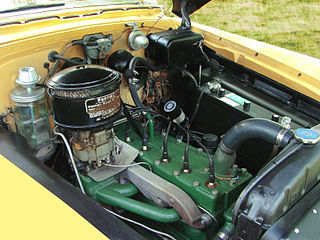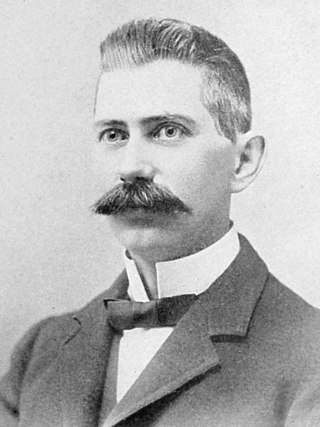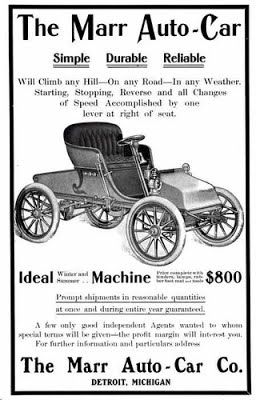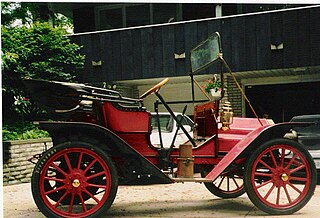
Buick is a division of the American automobile manufacturer General Motors (GM). Started by automotive pioneer David Dunbar Buick in 1899, it was among the first American automobile brands and was the company that established General Motors in 1908. Before the establishment of General Motors, GM founder William C. Durant had served as Buick's general manager and major investor. With the demise of Oldsmobile in 2004, Buick became the oldest surviving American carmaker. Buick is positioned as a premium automobile brand, selling luxury vehicles positioned below the flagship luxury Cadillac division.

Oldsmobile was a brand of American automobiles, produced for most of its existence by General Motors. Originally established as "Olds Motor Vehicle Company" by Ransom E. Olds in 1897, it produced over 35 million vehicles, including at least 14 million built at its Lansing, Michigan, factory alone.

Cadillac Motor Car Division, or simply Cadillac, is a division of the American automobile manufacturer General Motors (GM) that designs and builds luxury vehicles. Its major markets are the United States, Canada and China. Cadillac models are distributed in 34 additional markets worldwide. Historically, Cadillac automobiles were at the top of the luxury field within the United States, but have been outsold by European luxury brands including BMW and Mercedes since the 2000s. In 2019, Cadillac sold 390,458 vehicles worldwide, a record for the brand.

A camshaft is a shaft that contains a row of pointed cams in order to convert rotational motion to reciprocating motion. Camshafts are used in piston engines, mechanically controlled ignition systems and early electric motor speed controllers.

The straight-eight engine or inline-eight engine is an eight-cylinder internal combustion engine with all eight cylinders mounted in a straight line along the crankcase. The type has been produced in side-valve, IOE, overhead-valve, sleeve-valve, and overhead-cam configurations.

Abadal is a Spanish automobile company founded by the famous early 20th century racing driver Don Francisco Serramelera Abadal, better known as Paco Abadal, in Barcelona in 1912.

An overhead camshaft (OHC) engine is a piston engine in which the camshaft is located in the cylinder head above the combustion chamber. This contrasts with earlier overhead valve engines (OHV), where the camshaft is located below the combustion chamber in the engine block.

An overhead valve engine, abbreviated (OHV) and sometimes called a pushrod engine, is a piston engine whose valves are located in the cylinder head above the combustion chamber. This contrasts with flathead engines, where the valves were located below the combustion chamber in the engine block.

The Cadillac V16 engine is a term that applies to two different Cadillac-designed V-16 automobile engines, an overhead valve 45-degree 452 cu in (7.4 L) model produced between 1930 and 1937, and a 135-degree side valve 431 cu in (7.1 L) between 1938 and 1940. Both were used in its most luxurious model line, the Cadillac V-16.

The Pontiac straight-8 engine is an inline eight-cylinder automobile engine produced by Pontiac from 1933 to 1954. Introduced in the fall of 1932 for the 1933 models, it was Pontiac's most powerful engine at the time and the least expensive eight-cylinder engine built by an American automotive manufacturer. During its 21-year run displacement of the "eight" increased twice as platforms grew. It was superseded by Pontiac's new V8, the 287, in 1955. Engine block and cylinder heads were cast at Saginaw Metal Casting Operations then assembled at Tonawanda Engine before delivery to Pontiac Assembly for installation.

David Dunbar Buick was a Scottish-born American inventor, widely known for founding the Buick Motor Company. He headed this company and its predecessor from 1899–1906, thereby helping to create one of the most successful nameplates in United States motor vehicle history.

The Stutz Motor Car Company was an American automobile manufacturer based in Indianapolis, Indiana that produced high-end sports and luxury cars. The company was founded in 1911 as the Ideal Motor Car Company before merging with the Stutz Auto Parts Company in 1913. Due to the pressures of the Great Depression, the Stutz company went defunct in 1938. The Stutz Motor Car Company produced roughly 39,000 automobiles in their Indianapolis factory during their existence.

Marquette was an American automobile manufacturer established by General Motors in 1909 after the purchase of the Rainier Motor Car Company. The Marquette Company did not last long and in 1912 GM announced the company would be closed.

The Hackett was an automobile built in Jackson, Michigan, United States, by the Hackett Motor Car Company from 1916 to 1919.
The Janney was a brass era automobile assembled in Flint, Michigan by the Janney Motor Company in 1906.

The Marr Auto-Car was an automobile built in Elgin, Illinois by the Marr Auto-Car Company from 1902 to 1904.

The Buick Model B was Buick's first model as an independent company, later becoming part of General Motors in 1908. It was built in Jackson, Michigan. A model B was exhibited in 1905 at the New York Auto Show as a promotion of the model C which would be the same. William C. Durant introduced the car himself at the exhibit, and took new car orders at the car show, raising sales from 37 cars in 1904 to 750 in 1905. It had a 2-cylinder, horizontally opposed engine – the world's first production OHV engine – installed lengthwise within the frame, and had a planetary transmission with a cone clutch and two forward speeds, plus one reverse gear. The engine was rated at 21 bhp. In later years, it was renamed as improvements were made. The chassis was shared later with the Oldsmobile Model 20 when they became a division of GM while the overhead valve engine wasn't used by Oldsmobile. It had a retail price of US$950 for the touring sedan.
Leo William Goossen was a draftsman, mechanical engineer and automobile designer. He is known for his work with Harry Miller and his long involvement in the design and ongoing development of the four-cylinder Offenhauser ("Offy") racing engine.

The Buick Six was a top level automobile produced by GM's Buick Division which was first introduced in 1914, and was the senior vehicle to the Buick Series B Four. It was an all new platform which was shared with the Oldsmobile Six and was the first Buick to implement a steering wheel on the left side, and electric starter provided by Delco Remy along with an electric lighting system and electric Klaxon horn. The gearshift and emergency brake were relocated to a central position inside the vehicle, an approach used on all GM products for 1914. It continued to use the patented overhead valve engine implemented by Walter Lorenzo Marr while the cylinder head was not removable until later developments. The engine displacement was 331 cu in (5.4 L) and the wheelbase was 130 in (3,302 mm). The first year Buick Six was only offered as a touring sedan for US$1,985.

The Buick 60 Special is an early American racing car, two of which were built by Buick in 1910. It is one of the first US-built cars with just a single seat for the driver that was centrally located. The car is nicknamed the Buick Bug.

















